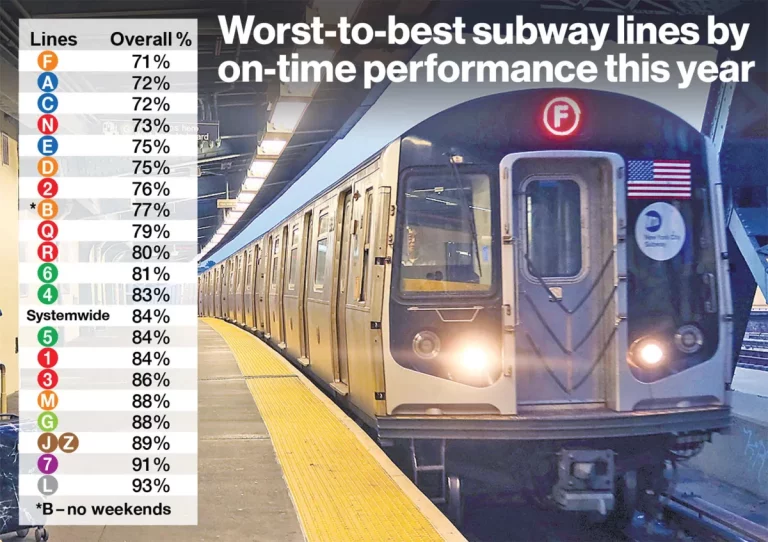NYC Being the Most Unreliable Subway Line: Examining the Challenges

NYC Being the Most Unreliable Subway Line: Examining the Challenges
Hey there! Ever wondered which subway line in New York City is the least dependable? Well, buckle up because we’re about to dive into the latest findings. Picture this: you’re rushing to catch the subway, hoping to make it to your destination on time, only to find out that your train is running late. It’s a frustrating situation that many New Yorkers experience regularly. But which subway line is the biggest culprit for these delays? Let’s unravel the mystery together as we explore the challenges facing NYC Being the Most Unreliable Subway Line.

What did the MTA data reveal about the F line?
Imagine waiting for a train, only to discover it’s running late. That’s a common frustration for many New Yorkers, especially those who rely on the subway to get around. Recent data from the MTA, the organization that runs the subway, reveals that some subway lines are more unreliable than others. For example, the F line, which runs from Brooklyn to Queens, has only 71% of its trains running on time. That means nearly 3 out of every 10 trains are delayed, leaving commuters stranded on platforms or squeezed into crowded cars.
Why do many commuters find the 7 train troublesome?
Many commuters find the 7 train troublesome because it’s often slow and packed, especially during busy times like rush hour. Imagine being squeezed into a subway car like a sardine! It can feel uncomfortable and cramped. Plus, delays are pretty common on the 7 train, especially on weekends and at night. So, if you’re in a hurry or trying to get somewhere on time, the 7 train might not be your best bet.

What problems do students mention about the E train?
Students mention a few problems with the E train. One big issue is that there are a lot of delays, especially on weekends and at night. This can be frustrating if you’re trying to get to school or home after a long day. Another problem is that sometimes homeless people camp out in the train stations, which can make students feel uncomfortable or unsafe. Overall, students find the E train to be unreliable and not very pleasant to ride.
According to the New York Times, what is one reason for delays in subway service?
According to the New York Times, one reason for delays in subway service is a chronic shortage of transit workers. This means that there aren’t enough people available to keep the subways running smoothly. As a result, riders might experience trains that come less often or trips that are canceled because there aren’t enough crews to operate them. This shortage of workers has been a long-standing issue that has contributed to delays and disruptions in subway service.

Key Facts
- Frequent Delays on the F Line: The F line emerges as the most unreliable subway line, with only 71% of trains running on time according to MTA data.
- Student Perspectives on Subway Troubles: Students express frustration with specific subway lines, such as the 7 train being slow and overcrowded, and the E train experiencing frequent delays.
- Chronic Shortage of Transit Workers: According to the New York Times, delays in subway service are attributed to a chronic shortage of transit workers, leading to reduced service frequency and canceled trips.
- Funding Disparities for Subway Stations: Some subway stations receive more funding than others, often depending on the wealth of the surrounding neighborhood. This results in disparities in station quality, with wealthier areas typically receiving more investment.
- Hope for Subway Improvement: Despite challenges, there is hope for subway improvement through potential upgrades like air conditioning and new turnstiles, signaling a commitment to enhancing the subway experience for commuters.
Why do some subway stations receive more funding than others?
Some subway stations receive more funding than others because they are located in wealthier areas. In places where people have more money, there’s often more investment in public infrastructure like subway stations. This means that stations in wealthier neighborhoods might have things like modernized turnstiles, cleaner platforms, and better maintenance overall. On the other hand, stations in less affluent areas might not receive as much funding, leading to issues like dirty platforms, broken equipment, and longer wait times for trains. This disparity in funding can contribute to inequalities in the quality of subway service experienced by different communities.
As we wrap up our exploration, one thing is clear: NYC Being the Most Unreliable Subway Line presents significant challenges for commuters. From delays and overcrowding to aging infrastructure, there’s no shortage of obstacles. However, there’s also hope on the horizon. With ongoing efforts to modernize and improve the subway system, we can work towards a future where delays are minimized, and reliability is increased. Together, we can ensure that NYC Being the Most Unreliable Subway Line becomes a thing of the past, providing a smoother and more efficient journey for all.














